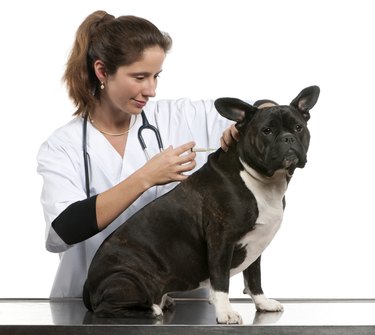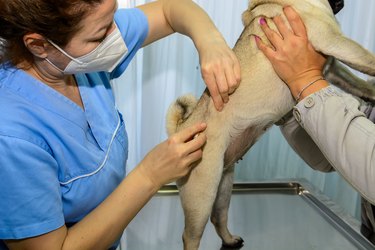Vaccines are a great barrier between your pet and harmful illnesses. While the amount and type will differ, if you have a dog, sooner or later you'll need to get them vaccinated. It can seem scary to someone unfamiliar with this important part of your pet's health care, but it's truly less daunting than it seems. Learn the ins and outs of the importance of various types of canine vaccinations as well as what to expect, the side effects, and in what part of your dog's body the vaccines will be administered.

Video of the Day
Should your dog be vaccinated?
Yes, your dog should be vaccinated, as most state laws require that your dog at least receive the rabies vaccine. Nationwide, it is highly recommended for the health and well-being of your dog (as well as any dog with whom they come in contact) that they also at the very least regularly receive the DHLPP vaccine. There are many risks involved in not vaccinating your dog.
Video of the Day
Bordetella bronchiseptica is the leading cause of kennel cough and can be extremely painful and even deadly in some cases. There is no cure for the canine distemper virus, which attacks the dog's respiratory system, GI tract, and nervous system. Canine hepatitis is a viral infection that can affect a dog's kidneys, liver, spleen, lungs, and eyes. Canine parvovirus attacks the gastrointestinal system, and while any age of dog is vulnerable, smaller and younger dogs are at a very high risk of death from it. Rabies is an incurable viral disease that invades the central nervous system.
A talk with your veterinarian can help you decide which vaccines are required, recommended, and unnecessary for your dog specifically. Some places, like groom shops and boarding, day care, or training facilities, may require certain vaccines before they'll allow you to benefit from their services. There are also higher risks associated with dogs who frequent dog parks, who live in certain regional areas, or who are around a high number of other animals.
Recommended (core) & non-core vaccines for dogs
In their first year, your new puppy will bravely endure a litany of vaccines and boosters meant to give immune system antibodies to protect them from various infectious diseases that are often life-threatening. The frequency of vaccines for adult dogs lowers to yearly, and depending on the vaccine, some, like the rabies shot, can be administered in doses that protect them for up to three years.
The core vaccines are DHLPP and rabies. The DHLPP combination vaccine protects your dog against distemper, hepatitis, leptospirosis, parvo, and parainfluenza. These vaccines can be administered during your dog's yearly exam.
If your dog needs a vaccine between their yearly visits, a good option is to attend a low-cost vaccine clinic. These are clinics held anywhere from shelters to veterinary offices to dog parks, bypassing a full wellness exam in order to save time and cost. However, while these clinics are designed to save money, they do not act as a replacement for your dog's yearly exam or regular veterinary care.

In what part of the body are dog vaccines given?
Vaccines are typically given subcutaneously, meaning under the skin. Your veterinarian will usually inject your dog's vaccine near their rear or front legs or around their hindquarters. These vaccines disperse into your dog's circulatory system relatively quickly and create lasting protection.
If your dog is receiving multiple shots at once, they'll likely be given in different areas. This is so that if your dog has a negative reaction to a vaccine, your veterinarian can be sure which vaccine it was.
Some vaccines for respiratory infections can be given intranasally, or through the nose or orally. These trigger the immune response in the dog's mucosa, boosting their immunity at the site where the virus might enter. This cuts off infections before they can infect the rest of the body.
Side effects of vaccines in dogs
Once your dog has received their vaccine, your veterinarian will typically discuss any side effects to look out for. Side effects are very rare and typically mild. The most common side effect for subcutaneous injections include a small, firm bump at the injection site. This usually goes away within a matter of days and shouldn't be painful. If your dog received their vaccination intranasally for something like the Bordetella vaccine, possible side effects include cold-like symptoms, such as sneezing, a mild cough, or a runny nose.
Other side effects include lethargy, slight fever, some mild discomfort, and your dog not acting like themself overall. If any of these side effects last for more than a day or two, contact your veterinarian.
More serious side effects to look out for include severe itchiness, hives, facial swelling, diarrhea, vomiting, difficulty breathing, and anaphylaxes. If you notice any of these in your dog, contact your veterinarian immediately.

The bottom line
Vaccines for dogs are typically given subcutaneously on or near your dog's legs or hindquarters. Puppies are on a puppy vaccination schedule receiving a series of vaccinations, while adult dogs need them less frequently. Some vaccines for respiratory viruses are given intranasally or orally. Your veterinarian can help you decide which vaccines are right for your dog and on what sort of schedule. They can also let you know what side effects to look out for and can treat any that are severe.